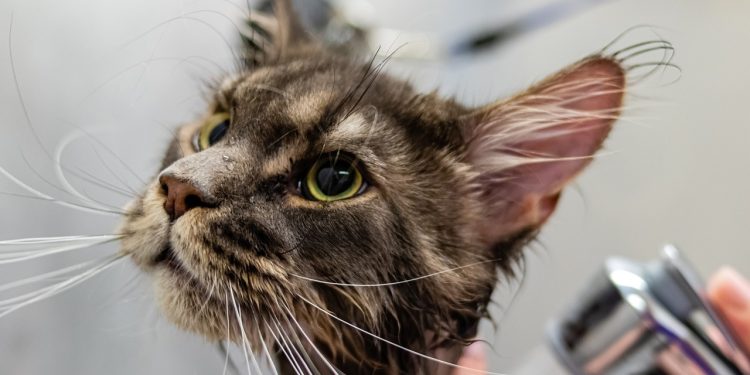Cats are known for their meticulous grooming habits. They spend hours every day licking themselves to keep their fur clean and smooth. However, there are times when your cat may need a proper bath, despite their best efforts to stay clean. Whether it’s due to a particularly sticky situation, a skin condition, or an unfortunate accident, bathing your cat may become necessary. Bathing a cat can seem like a daunting task—especially given that many cats are famously averse to water—but with the right approach and preparation, it can be done smoothly and with minimal stress. In this guide, we’ll walk you through everything you need to know about bathing your feline friend, from preparation to post-bath pampering.
When Should You Bathe Your Cat?
Most cats do not need regular baths. Their natural grooming behavior is usually sufficient for keeping them clean. However, there are certain situations where a bath is necessary:
- Medical Conditions: Cats with certain skin conditions may need medicated baths to treat infections, fleas, or other skin problems. Always consult your veterinarian before using medicated shampoos.
- Dirty or Sticky Fur: Sometimes, cats can get into situations that their tongues simply can’t handle. Whether it’s paint, grease, or other substances, a bath may be the only solution.
- Long-Haired Breeds: Long-haired breeds like Persians or Maine Coons may benefit from occasional baths, especially if their fur becomes matted or greasy.
- Elderly or Obese Cats: Older cats or cats that are overweight may have difficulty reaching certain areas of their body, leading to a build-up of dirt and oils. In these cases, a gentle bath can help maintain their hygiene.
Preparing to Bathe Your Cat
Preparation is key when it comes to bathing a cat. Ensuring that you have everything you need beforehand will make the process much smoother for both you and your cat.
- Choose the Right Shampoo: Always use a shampoo specifically formulated for cats. Human shampoos can be too harsh and may upset the pH balance of their skin, leading to irritation.
- Trim Nails: Cats may scratch when stressed, so it’s a good idea to trim your cat’s nails before attempting to bathe them. This helps prevent accidental injury to both of you.
- Brush First: Before you bathe your cat, give their fur a good brush to remove tangles and loose hair. This will make the bathing process easier and help prevent matting.
- Gather Supplies: Have everything within reach before you start. You will need cat shampoo, a pitcher or sprayer, a few towels, cotton balls, and possibly a comb for afterward. Having everything ready ensures you won’t have to leave your cat unattended.
- Set Up the Bathing Area: Use a sink or bathtub with a non-slip mat or towel at the bottom to prevent your cat from slipping. The bath area should be warm and free from drafts to keep your cat comfortable.
Step-by-Step Guide to Bathing Your Cat
Bathing a cat requires patience and a gentle approach. Here is a step-by-step guide to help make the experience as stress-free as possible:
Step 1: Create a Calm Environment
Before you begin, try to create a calm environment for your cat. Talk to them in a soft, soothing voice. If possible, enlist a helper who can hold and comfort your cat while you handle the bathing.
Step 2: Wet Your Cat’s Fur Gently
Start by wetting your cat’s fur. Use lukewarm water and pour it gently over their body, starting at the neck and moving down towards the tail. Avoid getting water on their face, ears, or eyes, as this can be particularly distressing for cats. A handheld sprayer or a plastic cup works well for this purpose.
Step 3: Apply Shampoo
Once your cat’s fur is thoroughly wet, apply a small amount of cat shampoo. Work the shampoo into a gentle lather, starting at the neck and moving downwards. Be sure to follow the directions on the shampoo bottle, especially if it is a medicated formula. Avoid scrubbing too hard, as this could irritate your cat’s skin.
Step 4: Rinse Thoroughly
Rinsing is one of the most important parts of the process. Any shampoo left in your cat’s fur can cause skin irritation. Use lukewarm water to rinse out all of the shampoo, making sure to work from the top of the body down to the tail. You may need to rinse multiple times to ensure that no residue is left behind.
Step 5: Cleaning the Face
Cats generally do not appreciate having their faces submerged in water. Instead of trying to wet their face directly, use a damp washcloth to gently wipe their face, avoiding the eyes and inside the ears. If needed, use a cotton ball to gently clean the outer areas of the ears.
Step 6: Drying Your Cat
After the bath, wrap your cat in a large, soft towel to absorb as much water as possible. Pat the fur gently rather than rubbing, as rubbing can cause tangles or stress to your cat. If your cat tolerates it, you can use a blow dryer on a low, cool setting to help dry their fur, but many cats will not like the noise or sensation. If your cat shows signs of distress, stick with towel drying.
Tips for Keeping Your Cat Calm
Most cats do not enjoy baths, but there are ways to make the experience less stressful:
- Introduce Water Gradually: If your cat has never been bathed before, introduce them to the bath slowly. Let them explore the empty tub or sink first, and gradually add a small amount of water over time.
- Use Treats: Give your cat their favorite treats throughout the process as a positive reinforcement. This can help them associate the bath with something positive.
- Keep Sessions Short: Don’t prolong the experience more than necessary. Aim to keep the bathing session under 10 minutes to minimize stress.
- Choose the Right Time: It’s best to bathe your cat when they are feeling calm and relaxed. After a play session or meal, they may be more inclined to cooperate.
Post-Bath Grooming
After your cat is dry, it’s a good idea to give them another gentle brush to help remove any tangles that may have formed during the bath. Brushing also helps distribute the natural oils in their coat, leaving it soft and shiny. You may also want to check their ears for any remaining moisture and gently clean them with a cotton ball if necessary.
Common Mistakes to Avoid
Bathing a cat can be challenging, and it’s easy to make mistakes that could make the experience worse for your feline friend. Here are some common mistakes to avoid:
- Using the Wrong Shampoo: Never use human shampoo on a cat. Human shampoos can dry out and irritate a cat’s skin due to differences in pH levels. Always use a shampoo specifically formulated for cats.
- Forcing Your Cat: Never force your cat into the water or try to restrain them too tightly. This can cause your cat to panic and possibly injure themselves or you. A gentle approach works best.
- Neglecting Rinsing: Failing to rinse thoroughly is a common mistake. Shampoo residue left on the skin can cause irritation, so be sure to rinse until all of the suds are gone.
Alternatives to Traditional Bathing
If your cat absolutely cannot tolerate a traditional bath, there are alternatives that can help keep them clean:
- Waterless Shampoos: Waterless shampoos or cat-safe grooming wipes are available and can be used to clean your cat without needing to rinse. These are particularly helpful for spot-cleaning.
- Professional Grooming: If bathing your cat at home is too stressful for both of you, consider taking them to a professional groomer who has experience handling anxious cats.
- Brushing: Regular brushing can help reduce the need for frequent baths by removing dirt, dander, and loose fur. For most cats, brushing is much more enjoyable than bathing and provides an effective way to keep their coat in good condition.
How to Know if Bathing Is Necessary
Many cat owners wonder how to know if their cat actually needs a bath. As a general rule, if your cat’s coat is in good condition—clean, shiny, and free of mats or odors—then there’s probably no need for a bath. However, if your cat has gotten into something messy or is dealing with a medical condition that requires frequent bathing, then it’s time to prepare for a bath.
Senior cats or cats with mobility issues may also need occasional baths, as they may not be able to groom themselves as effectively as they used to. If you notice any build-up of oil, dirt, or an unpleasant odor, then it’s likely time for a gentle bath.
Final Thoughts on Bathing Cats
Bathing a cat may not be anyone’s idea of fun, but there are times when it’s necessary for the health and cleanliness of your feline friend. With patience, the right tools, and a gentle approach, you can help make the experience as stress-free as possible for both of you. Remember, each cat is unique—some may never truly enjoy a bath, while others might tolerate it quite well. Understanding your cat’s individual needs and providing reassurance throughout the process can make all the difference in maintaining their health and happiness.













Discussion about this post